|
John Tyman's Cultures in Context Series www.johntyman.com 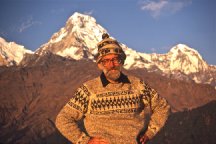
NEPAL Video Extracts Contents Parts III-V Topic and Duration in Minutes and Seconds . |
|
John Tyman's Cultures in Context Series www.johntyman.com 
NEPAL Video Extracts Contents Parts III-V Topic and Duration in Minutes and Seconds . |
|
26. The National Capital (13’22”) Part Four : Religion 27. Daily Puja (5’22”) 28. Devghat : Place of Refuge and Learning (9’16”) 29. Kalika Mandir and Blood Sacrifice (6’18”) 30. Kasara, Little Dasain and Bikram Baba (6’38”) 31. Pashupatinath : Cremation and Ritual Cleansing (14’44”) 32. Buddhist Shrines in Kathmandu (8’18”) Part Five : Conclusion 33. Migration and Change (2’45”) |
|
www.johntyman.com/nepal |
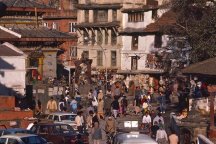 |
26. Kathmandu. (13’22”) The greater bulk of Kathmandu’s rain falls during the monsoon, in June through August: but occasional storms cause flooding at other times. In commercial sections of the city a blend of ancient and modern offers employment to at least some of those who have moved here from rural areas. And the carpet industry employs young people with nimble fingers. As the city expands new homes are built on its outskirts. This one replaced old farm buildings. It was built of brick instead of stone, but the mortar was still mud. Despite a strong wind there was little concern for the safety of those involved. And those who live in these new homes still do some things in the old way (in this case sorting rice), while in the room below children were glued to the TV, though the reception was less than ideal. Some shows are produced in Nepal, but most are made in India, in Bollywood. |
VIDEO EXTRACTS PART IV CONTENTS
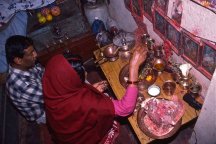 |
27. Religion: Daily Puja. (5’22’) The obligation to pray daily was discharged in various ways. In Bharatpur my friend’s wife would sometimes walk to the nearest shrine or temple: but she had a small shrine of her own in the kitchen and also worshipped in front of the sandalwood tree behind her house -- in a sacred space occupied in this case by visiting priests. Her sister, living in Kathmandu and married to a government official, had a large house with a room reserved for prayer. It was decorated with coloured prints and images representing a range of deities. There was a bell also, a large conch shell (which only men can blow) and a smaller one for ceremonial use, copper pots filled with milk and water, and a dish where incense is burned. Each day a puja plate would be prepared, typically with husked rice, plus incense, vermillion powder, wicks soaked in oil, red sandalwood juice, flowers, and sometimes grains of barley. Parbati would smear the deities with vermillion powder and sandalwood juice, sprinkle them with rice, and burn the barley (if any) in a small brazier. Prayers and holy mantras would be chanted before her husband leaves for work , in a complex series of religious exercises. |
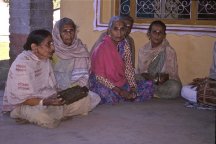 |
28. Devghat
: Place of Refuge and Learning. (9’16”) Devghat is one of
the holiest places in Hindu mythology, lying at the junction of the Sapta
Gandaki and Krishna Gandaki. Its new suspension bridge is used by people
moving between the religious and secular sections of the town. Since
both rivers flow into the sacred Ganges eventually, their banks are a favoured
site for cremations.
A wealthy sadhu sold her house and land and used the money to finance the building of two temples and a refuge for widows waiting to die. With nothing else to look forward to they spend their time here in worship, waiting for the chance to depart this life and begin over again. (I have merely pieced together extracts from a lengthy chant.) The bell is rung as an invocation to the gods, and summons the monks to prayer. Among Brahmans male mourners traditionally shave their hair and some monks do also. Close by there was a school for priests, at which students committed to memory the Hindu holy books ... in Sanskrit. The boys were sent here by their parents as a gift to God (though the older ones, apparently, were drop outs from secondary school). There was also a school for blind children from villages far and wide. It had been opened for only three months, and had 10 students, one teacher, and aids which were generally improvised. The government provided the building and the teacher’s salary, and paid the school 1,000 rupees a month to house, feed and clothe the children: but donations from overseas were needed to help it operate properly. |
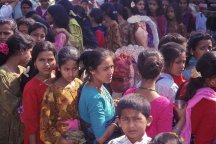 |
29. Kalika
Mandir and Blood Sacrifice. (6’18”) At Little Dasain our neighbours
slaughtered a goat early in the day in preparation for their family’s feast,
and removed the hair from both the head and the body -- in front of their
house, and only a few metres from the highway. Presumably this animal could
not have been killed at the temple, as only males capable of reproduction
are acceptable as offerings: those that have been gelded are clearly imperfect.
Gopal and I left for the Kalika Mandir (a temple honouring the goddess Kali) near Bharatpur, joining pilgrims climbing the slopes of a steep hill, and by-passing those who had worshipped earlier. There was a rest station part-way up but most people headed straight for the top. Here, close to the temple, they could purchase items they needed for acts of puja, together with animals they could sacrifice. While some people picnicked, others queued to enter the temple with their offerings. Those who had already been inside displayed tikas of vermillion-coloured rice applied by one or other of the priests on duty inside. Some Brahman families brought their own priests, though, and worshipped separately. This one family brought five animals to sacrifice. The festive nature of the occasion was highlighted by tape-recorded music broadcast by loudspeakers attached to the (yet incomplete) walls of the temple. Worship at a mandir like this is aided by stone images infused with the presence of the god who is worshipped there. Some are representations of the deity, some of animals, others are symbolic icons: but all are honoured in one way or another. Kali, “She who destroys” is Shiva’s consort Parvati in her most terrifying form and many of the families who visited the temple brought animals and birds to sacrifice -- goats, chickens and pigeons. They are killed only after their owners (or purchasers) have worshipped in the temple, and the animals may be fed some of the grain blessed during the ceremony. Each goat, sheep or chicken will be sprinkled with flour and water. If the animal shakes it off it’s a sign that the god is pleased with the sacrifice offered. If it does not shake it off, more water is applied till it does. Then it is killed. Its blood will be spread around to earn Kali’s favour. Its head will be retained by the temple staff (priests and ritual executioners) and the body carried home. As they leave, everyone will anoint the temple bell with vermillion and ring it, signifying the completion of their worship. |
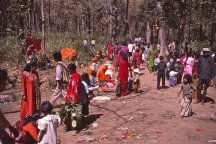 |
30. Kasara,
Little Dasain and Bikram Baba. (6’38”) Little Dasain (or “Chait”)
is celebrated in March and honours the goddess Durga, consort of Shiva
in one of her more awesome forms. We began our celebrations at a holy place
in a national park, near Kasara. And we travelled there with a “picnic
party” from a local women’s group, in the back of a truck fitted out as
a bus. Others arrived in open carts.
Everyone had to wait their turn to cross the river Rapti-- so there was time for ritual bathing. Boats were moving in both directions because those who had visited the shrine early in the day were returning to the picnic grounds. Disembarking on the other side of the river, we walked through the forest to the site of the celebrations. Durga embodies the supreme power in all that is female, and the shedding of blood is a key element of ceremonies during the festival. Since Kasara had only recently been declared a holy place there was no temple, and sacrificial blood was sprinkled over and around objects which were symbolic of the god they worshipped then. This post was capped by a trident or trisul, the sign of Shiva, the destroyer. Those who could not afford to sacrifice sheep or goats brought pigeons or chickens. Ten years earlier a man had found, at the foot of a tree, a stone which was (seemingly) shaped like Bikram Baba, a god popular with the indigenous Tharus. It was subsequently determined that people who came here to pray with faithful hearts would have their wishes granted. Offerings were made beside the holy tree where Bikram Baba’s image had been found. There was a shrine close by, around which people processed clockwise (as usual) carrying puja plates, ringing bells and praying. The forest then was a hive of activity, with beggars, stallholders selling objects used in the preparation of ritual offerings. And much time, prayer and effort was given to the preparation of puja dishes, by men as well as women. Afterwards we returned to the picnic grounds on the other side of the river, where people feasted on the bodies of the animals whose blood had been shed. There were sideshows, too, games, and music for dancing played over loud speakers. It was both holy day and a holiday. |
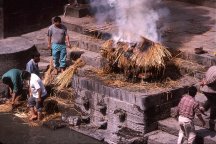 |
31. Pashupatinath
: Cremation and Cleansing. (14’44”) Hindus are not buried
when they die but are cremated wherever possible on the banks of a stream
which will carry their ashes to the Ganges river. The opening sequence
shows the procession of a poor man near Bharatpur: but the preferred place
for cremations is the temple of Pashupatinath in Kathmandu.
Situated on the Bagmati River (which eventually joins the Ganges) the temple at Pashupatinath is a focus for pilgrims who come with offerings which demonstrate their reverence for Shiva ... whose presence is signified by a series of stone phalluses. Women come here at the end of their menstrual cycles to purify themselves, changing into new saris afterwards. It is a place for ritual bathing also. At cremation the spirit of the deceased is released, so the corpse is rotated several times before it is burned, to confuse its spirit so it will not be able later to find its way back into the same body. The round burning ghats (platforms) in front of the temple were reserved for royalty. The square ones are for commoners. Prior to its cremation the body will be wrapped in a yellow shroud because this is the colour ascribed to Shiva; and it will be encircled for between three to seven times by those paying their respects. The ritual of cremation can properly be performed only by sons of the deceased. If no son is available the family will need to hire a man to do the job. The corpse will be screened while it is prepared. White, rather than black, is the colour of mourning: and among Brahmans the deceased will be mourned for 13 days by surviving members of the family. After the body has been placed on the pyre, water, rice and ghee will be placed in the mouth of the deceased, and the pyre will be covered in damp straw to ensure a slow burn. While bodies are prepared for cremation at different points in front of the temple, stallholders market ceremonial items, and a stream of women pay homage to Shiva’s lingam and scoop holy water from the river. |
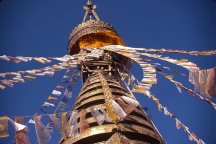 |
32. Buddhist
Shrines in Kathmandu. (8’18”) The shrines at Bodhnath and Swayambhunath
were founded in about 250 B.C. and are among the oldest cultural monuments
in South-East Asia. The stupa at Bodhnath is the largest one in
Nepal, and one of the largest anywhere in the world. Its base is laid out
like a mandala -- in a geometrical combination of circles
and squares that symbolises the universe and the spiritual forces in Buddhism.
Its perimeter is marked by three circles, beginning with an outer ring
of buildings to accommodate pilgrims, and shops selling religious icons
and souvenirs. Next there is a ring road, and thirdly an exterior wall
with 147 niches each containing four or five prayer wheels. Pilgrims activate
these as they circumnavigate the stupa, praying as they do so. When
they are rotated the prayers written on rolls of paper inside the
cylinders are said to be offered again and again. Similarly, prayer flags
flapping in the wind are believed to recite with every movement the prayers
written on them.
In their construction all stupas have the same form, and every element is charged with meaning. They all have a rectangular base, which symbolises the earth. The white dome above it represents water. The spire symbolises fire. The 13 concentric rings which form the tower reflect the 13 steps one must take to attain enlightenment. The steps end in a ring or "umbrella" symbolising air, which is crowned by symbols of the sun and the moon. The stupa's four pairs of lotus-shaped eyes symbolise wisdom incarnate. What looks like a nose is actually the number ek or "1", signifying the oneness of all life. Some of the images surrounding the stupa reflect the links between Nepalese Buddhism and Hinduism, but in the adjacent gompas (temples) Buddha reigns supreme and serene. Every day thousands climb the steps to the stupa at Swayambhunath, running a gauntlet of tourist attractions, stall holders and Hindu deities. At the top they come face to face with the thunderbolt or vajra (on its round base) which symbolises the Absolute and, as such, is male. Its female counterpart is the bell or ghanta, which symbolises female wisdom. The links to the local Tibetan community are obvious from the faces of those spinning the prayer wheels, but there were Hindus here too. And, as at Hindu shrines, people waited in line with their offerings. The target that day had been to light 10,000 candles for Buddha. There were foreign tourists there also, plus beggars, and even Hindu holy men seeking alms. Inevitably there were troops of monkeys, but no animal sacrifices -- in light of Buddhist respect for all sensate beings. |
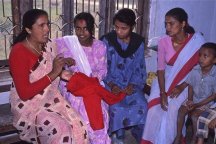 |
33. Migration
and Change. (2’45”) Today many people do not spend their
entire life in the village or town where they were born, as they once did.
Many move seeking work; others are displaced. Migrant laborers from India,
living in temporary camps, do some of the heavier labouring jobs here today,
digging the ditch alongside this road, for example.
The Refugee Camp was full of Nepalese villagers who had been displaced by floods and landslides in the hill country. Sadly, they had failed to learn from the experience and were continuing to damage the tree cover, in search of wood for cooking fires. Tourism, long the mainstay of foreign income in mountainous sections of Nepal, is now important also on the plains ... and a conduit for cultural change. With malaria no longer the threat it once was, tourists with cameras flock to the Chitwan National Park and ride elephants in search of rhinos and tigers. Migration has also blurred the boundaries between ethnic and religious groups in Nepal. The Terai is now a cultural melting pot. At this self-help gathering, for example, women from different groups, who would have had little contact with one another in their former homes, are now learning together how to sew clothes for their families -- a task which previously was assigned to lower occupational castes. |
![]()
Text, photos, videos and recordings
by John Tyman
Intended for Educational Use
Only.
Contact Dr. John Tyman at johntyman2@gmail.com
for more information regarding
licensing.
![]()
www.hillmanweb.com
Photo processing, Web page layout,
formatting and hosting by
William
Hillman ~ Brandon, Manitoba ~ Canada